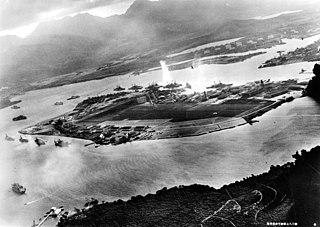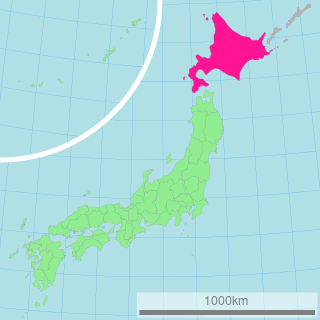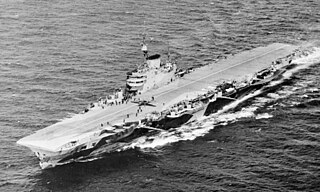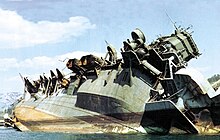
The Battle of Leyte Gulf is considered to have been the largest naval battle of World War II and, by some criteria, possibly the largest naval battle in history, with over 200,000 naval personnel involved. It was fought in waters near the Philippine islands of Leyte, Samar, and Luzon, from 23–26 October 1944, between combined American and Australian forces and the Imperial Japanese Navy (IJN), as part of the invasion of Leyte, which aimed to isolate Japan from the countries it had occupied in Southeast Asia which were a vital source of industrial and oil supplies.

Yamato (大和) was the lead ship of her class of battleships built for the Imperial Japanese Navy (IJN) shortly before World War II. She and her sister ship, Musashi, were the heaviest and most powerfully armed battleships ever constructed, displacing 72,800 tonnes at full load and armed with nine 46 cm (18.1 in) Type 94 main guns, which were the largest guns ever mounted on a warship.

Haruna (榛名) was a warship of the Imperial Japanese Navy during World War I and World War II. Designed by the British naval engineer George Thurston and named after Mount Haruna, she was the fourth and last battlecruiser of the Kongō class, amongst the most heavily armed ships in any navy when built. Laid down in 1912 at the Kawasaki Shipyards in Kobe, Haruna was formally commissioned in 1915 on the same day as her sister ship, Kirishima. Haruna patrolled off the Chinese coast during World War I. During gunnery drills in 1920, an explosion destroyed one of her guns, damaged the gun turret, and killed seven men. During her career, Haruna underwent two major reconstructions. Beginning in 1926, the Imperial Japanese Navy rebuilt her as a battleship, strengthening her armor and improving her speed and power capabilities. In 1933, her superstructure was completely rebuilt, her speed was increased, and she was equipped with launch catapults for floatplanes. Now fast enough to accompany Japan's growing carrier fleet, Haruna was reclassified as a fast battleship. During the Second Sino-Japanese War, Haruna transported Imperial Japanese Army troops to mainland China before being redeployed to the Third Battleship Division in 1941. On the eve of the Japanese attack on Pearl Harbor, she sailed as part of the Southern Force in preparation for the Battle of Singapore.

Chikuma was the second and last vessel in the Tone class of heavy cruisers in the Imperial Japanese Navy. The ship was named after the Chikuma River, in Nagano prefecture of Japan. Entering service in 1939, Chikuma saw battle during World War II in the Pacific. She was scuttled on 25 October 1944 after the Battle off Samar.

Myōkō (妙高) was the lead ship of the four-member Myōkō class of heavy cruisers of the Imperial Japanese Navy (IJN), which were active in World War II. She was named after Mount Myōkō in Niigata Prefecture. The other ships of the class were Nachi, Ashigara, and Haguro.
Tone was the lead ship in the two-vessel Tone class of heavy cruisers in the Imperial Japanese Navy. The ship was named after the Tone River, in the Kantō region of Japan and was completed on 20 November 1938 at Mitsubishi's Nagasaki shipyards. Tone was designed for long-range scouting missions and had a large seaplane capacity. She was extensively employed during World War II usually providing scouting services to their aircraft carrier task forces. She almost always operated in this capacity in conjunction with her sister ship Chikuma.

The Indian Ocean raid was a naval sortie by the fast carrier strike force of the Imperial Japanese Navy from 31 March to 10 April 1942 against Allied shipping and bases in the Indian Ocean. It was an early engagement of the Pacific campaign of World War II. The Japanese under Chūichi Nagumo compelled part of the Allied forces to retreat to East Africa, but Admiral Sir James Somerville kept his fast carrier division, Force A, "...in Indian waters, to be ready to deal with any attempt by the enemy to command those waters with light forces only."

The Kongō-class battlecruiser was a class of four battlecruisers built for the Imperial Japanese Navy (IJN) immediately before World War I. Designed by British naval architect George Thurston, the lead ship of the class, Kongō, was the last Japanese capital ship constructed outside Japan, by Vickers at Barrow-in-Furness. Her sister ships Haruna, Kirishima and Hiei were all completed in Japan.

Uranami was the tenth of twenty-four Fubuki-class destroyers, built for the Imperial Japanese Navy following World War I. When introduced into service, these ships were the most powerful destroyers in the world. They served as first-line destroyers through the 1930s, and remained formidable weapons systems well into the Pacific War.

Maya (摩耶) was one of four Takao-class heavy cruisers, active in World War II with the Imperial Japanese Navy (IJN). These were the largest and most modern cruisers in the Japanese fleet, and were intended to form the backbone of a multipurpose long-range strike force. These ships were fast, powerful and heavily armed, with enough firepower to hold their own against any cruiser in any other navy in the world. Her sister ships were Takao, Atago and Chōkai.

Kinu (鬼怒) was the fifth of the six ships completed Nagara-class light cruiser in the Imperial Japanese Navy, named after the Kinu River in Tochigi prefecture Japan. She was active in World War II in various campaigns in Malaya, the Dutch East Indies and New Guinea before being sunk by United States Navy carrier-based aircraft in the Philippines in 1944.

Kako was the second vessel in the two-vessel Furutaka class of heavy cruisers in the Imperial Japanese Navy. The ship was named after the Kako River in Hyogo prefecture, Japan.

Shigure was the second of ten Shiratsuyu-class destroyers, and the first to be built for the Imperial Japanese Navy under the Circle One Program. Along with the destroyer Yukikaze, she developed a reputation within the Imperial Japanese Navy for being "lucky" or "unsinkable", emerging undamaged from several battles and as the sole surviving Japanese warship from two. As the flagship of Captain Tameichi Hara's Destroyer Division 27 Shigure received a prominent place in the memoirs of the only Japanese destroyer captain to survive the entire Pacific War. Shigure was torpedoed and sunk by the submarine USS Blackfin in the Gulf of Siam on 24 January 1945.

Kasumi was the ninth of ten Asashio-class destroyers built for the Imperial Japanese Navy in the mid-1930s under the Circle Two Supplementary Naval Expansion Program.
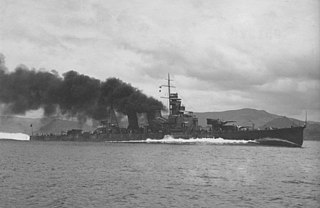
Aoba was the lead ship in the two-vessel Aoba class of heavy cruisers in the Imperial Japanese Navy. Launched in 1926 and heavily modernized in 1938-40, Aoba initially served as a patrol craft, largely along the China coast, and saw extensive service during World War II. Repeatedly heavily damaged and repaired, she was finally crippled by bombing and settled on the bottom of shallow Kure harbor in April 1945; two raids in late July reduced her to an unsalvageable hulk.
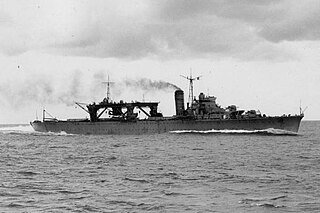
Chiyoda was a light aircraft carrier of the Imperial Japanese Navy during World War II. Originally constructed as the second vessel of the Chitose-class seaplane tenders in 1934, she continued to operate in that capacity during the Second Sino-Japanese War and the early stages of the Pacific War until her conversion into a light aircraft carrier after the Battle of Midway. She was sunk during the Battle of Leyte Gulf by a combination of naval bombers, cruiser shellfire and destroyer-launched torpedoes.

Operation Kita was conducted by the Imperial Japanese Navy (IJN) during the Pacific War in February 1945. Its purpose was to return two Ise-class hybrid battleship-aircraft carriers and four escort ships to Japan from Singapore, where they had been based since November the previous year. The movement of the Japanese force was detected by the Allies, but all attempts to attack it with submarines and aircraft failed. Nevertheless, as a result of the intensifying Allied blockade of Japan, the Ise-class battleship-carriers and their escorts were among the last IJN warships to safely reach the country from the Southwest Pacific before the end of the war.

The attack on Yokosuka was an air raid conducted by the United States Navy on 18 July 1945 during the last weeks of the Pacific War. The Japanese battleship Nagato was the raid's main target, though anti-aircraft positions and other warships at Yokosuka Naval Arsenal were also attacked. Other U.S. Navy and British Royal Navy aircraft struck airfields in the Tokyo area.

The South China Sea raid was an operation conducted by the United States Third Fleet between 10 and 20 January 1945 during the Pacific War of World War II. The raid was undertaken to support the liberation of Luzon in the Philippines, and targeted Japanese warships, supply convoys and aircraft in the region.

The attack on Kure was an air raid conducted during the Pacific War by the United States Navy on 19 March 1945. It targeted the remnants of the Japanese Combined Fleet located in and near the Japanese city of Kure. The attack by 321 aircraft was unsuccessful, as no Japanese warships were sunk though several were damaged. Japanese forces struck the American fleet on the morning of 19 March, and crippled one aircraft carrier and badly damaged another.





